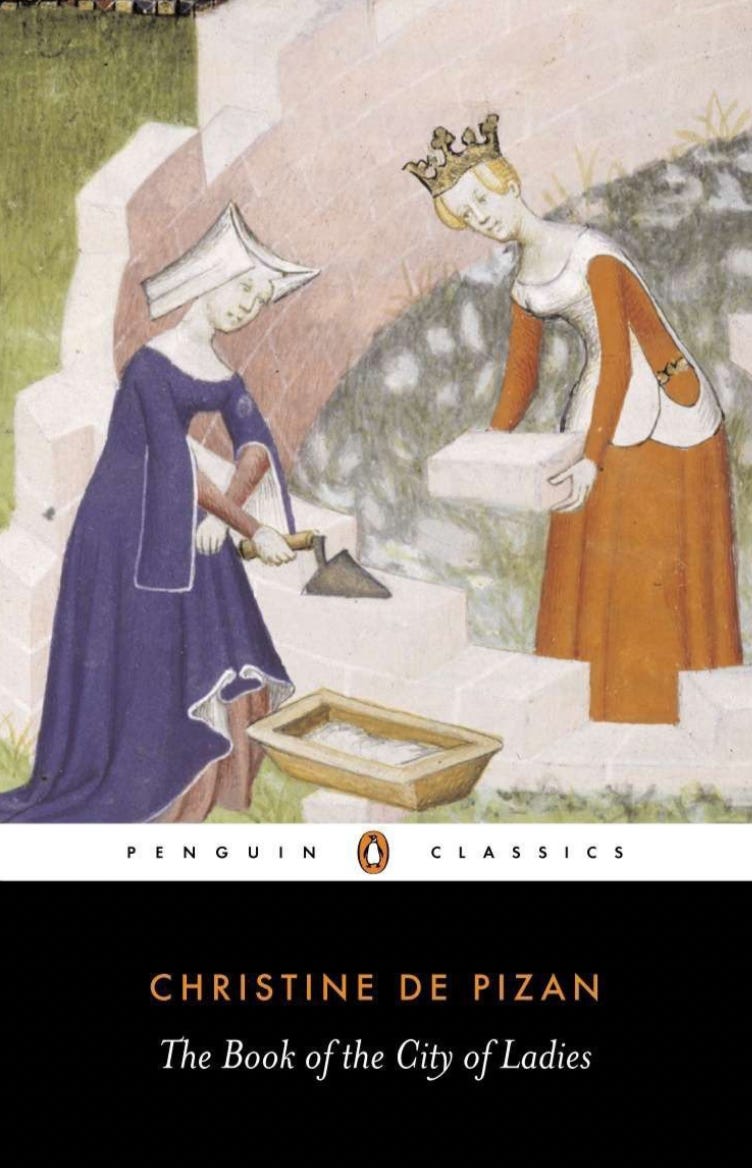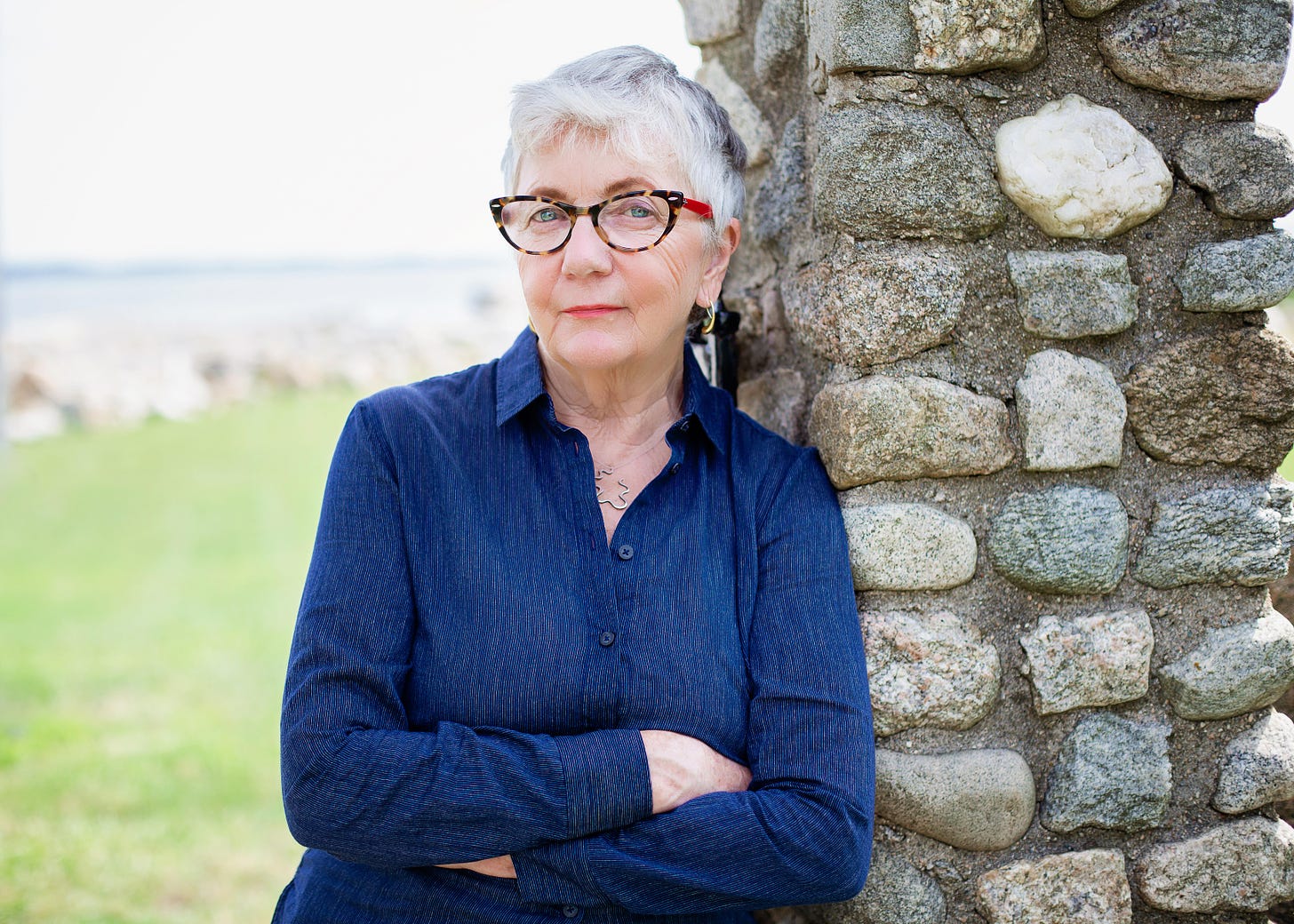A Book I Wish More People Knew About Vol. 8
Learning from a fifteenth-century defense of women
The previous installment of “A Book I Wish More People Knew About” reached back to Poland in the 1920s, and today’s recommendation extends even deeper into the past. Christine de Pizan’s The Book of the City of Ladies, written in France in the fifteenth century, served as an inspiration for Kathleen B. Jones’s new novel Cities of Women, published this month by indie Keylight Books. I’m grateful to Kathleen for sharing perspective on a very old book that helped shape her new work.
A Book I Wish More People Knew About: Kathleen B. Jones on The Book of the City of Ladies, by Christine de Pizan
Two decades ago, as part of my university’s initiative with a local high school to increase student literacy and interest in reading, I was invited to read aloud excerpts from an “important” book to a freshman English class, many of whom were English as a Second Language (ESL) speakers, recent immigrants from various countries in Asia, Africa, and Latin America. I chose Christine de Pizan’s Book of the City of Ladies to share.
I have long wondered about the reasons why so many different men, whether learned or not, have been so ready to say and write so many evil and reproachful things about women. (de Pizan)
Selecting a book from the fifteenth century to read to a classroom of modern teenagers might seem counterintuitive. Yet, because Christine’s views sound so anachronistically modern, I thought I’d surprise the students when I revealed the time period in which she wrote.
“In what century do you think this book was written?” I asked.
“Sounds like one of those angry feminists,” a student shouted from the back row. “Has to be recent.”
When I told them the writer was a widowed woman who lived in France in the fifteenth century and supported herself, her mother, and three children with income she earned from writing books, they were stunned.
“You’re joking,” another student said. “I thought women didn’t even know how to read or write back then.”
“In the middle ages, most people weren’t literate,” I said. “Christine was an exception. She was privileged. Her father worked in the French court of King Charles V and believed his daughter should be educated. So she learned to read and write several languages, including Latin and French, and used her knowledge to advocate for women and engage with the political issues of her times.”
They asked me to read more from the book, and in fact I spent the remainder of the hour reading excerpts from The Book of the City of Ladies, Christine’s defense of women as leaders, thinkers, warriors, artists, poets, scientists, prophets, and mystics.
I trace the germ of the idea for my novel, Cities of Women, back to my experience twenty years ago in that high school classroom. If Christine’s writing could intrigue a group of modern teenagers, her words might enthrall an even wider array of readers if they traveled beyond the halls of academia.
Le Livre des Dames, or The Book of the City of Ladies, is a stirring, allegorical counter-narrative, a revisionist history correcting centuries of philosophical treatises and poetic works attacking women as intellectually, morally, culturally, and physically inferior creatures. Influenced by Dante’s Divine Comedy, among other sources, the book recounts its author’s own dark night of the soul and how she learned to reject the many falsehoods written about women.
Sitting in her study one evening, Christine reaches for a book on her shelf, a widely discussed volume by a thirteenth-century writer named Matheolus, who had a decidedly dim view of women. After reading this and other “treatises of philosophers and poets and . . . orators” who contended that “woman was the vessel as well as the refuge and abode of every evil and vice,” she falls into a stupor. Tortured by these opinions, she loses all perspective, “relying more on the judgment of others than on what I myself felt and knew.” Her unhappiness becomes so profound she begins to detest herself “and the entire feminine sex,” lamenting that God made her “inhabit a female body in this world.”
It’s remarkable how accurately this fifteenth-century woman describes what we now identify as internalized oppression. Equally remarkable is how she writes herself back from the abyss.
On the brink of despair, she describes a “ray of light” appearing in her study, revealing “three crowned ladies” who illuminate the room. These revenants are the incarnation of the virtues of Reason, Rectitude, and Justice. They urge Christine to come back to her senses, discard false beliefs, and trust what she knows “with certainty.” They tell her she’s been chosen to build “with the trowel of [her] pen” a fortress—a City of Ladies—in defense of women. In other words, stop being hoodwinked by misogynist hogwash, the cascade of patriarchal lies designed to subjugate women, and use your intelligence and craft to defeat ignorance.
What follows is an encyclopedia of women’s contributions to history, an iconoclastic rewriting of mythical and historical women’s lives in a positive light by a woman who unequivocally occupies the authorial “I”: Je, Christine. Her legacy can be found in works of fiction and nonfiction that have reinterpreted stories of women either forgotten, misunderstood, or vilified.
Earl Jeffrey Richards’s translation of Le Livre des Dames from medieval French to English first appeared in 1982. Before that, the last English translation was in 1521. In the intervening years, attitudes toward women underwent seismic shifts. If Christine’s vigorous criticism of men’s attitudes toward women put her ahead of her times, her support for a wife’s obedience to a husband marked her feminism as dated. Yet, her unambiguous rejection of the idea that sex determines intelligence or behavior makes reading The Book of the City of Ladies an eye-opener, even today.
“Neither the loftiness nor the lowliness of a person lies in the body according to the sex, but in the perfection of conduct and virtues.”
Born and educated in New York City, Kathleen B. Jones taught feminist theory for twenty-four years at San Diego State University. In addition to many scholarly books, she wrote two memoirs: Living Between Danger and Love (Rutgers University Press, 2000) and the award-winning Diving for Pearls: A Thinking Journey with Hannah Arendt (Thinking Women Books, 2015). Her newest book is a novel, Cities of Women.
Previously in “A Book I Wish More People Knew About”
Vol. 1: The Actual True Story of Ahmed and Zarga, recommended by Phyllis Mann.
Vol. 2: Laura & Emma, recommended by Teddy Wayne.
Vol. 3: The Woman Lit by Fireflies, recommended by Christine Sneed
Vol. 4: This. This. This. Is. Love. Love. Love., recommended by Casey Plett
Vol. 5: The Breaks by Julietta Singh, recommended by Neema Avashia
Vol. 6: The Circus Train by Judith Kitchen, recommended by Beth Kephart
Vol. 7: The Story of the Paper Crown by Józef Czechowicz, recommended by K.E. Semmel






Loved this essay, and am about to read Cities of Women, coincidentally (I’ll be Kathleen’s conversation partner for her Zibby’s Books event on 9/18 📗 !)
I was lucky enough to read *The Book of the City of Ladies* in a college class and loved it immensely. I'll have to check out *Cities of Women* now!